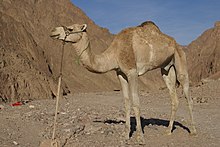
Dromedary camel

The dromedary (/ˈdrɒmədɛri/ or /-ədri/), also called the Arabian camel (Camelus dromedarius), is a large, even-toed ungulate with one hump on its back. The dromedary is the tallest of the three species of camel; adult males stand 1.8–2 m (5.9–6.6 ft) at the shoulder, while females are 1.7–1.9 m (5.6–6.2 ft) tall. Males typically weigh between 400 and 600 kg (880 and 1,320 lb), and females weigh between 300 and 540 kg (660 and 1,190 lb). The species' distinctive features include its long, curved neck, narrow chest, a single hump (compared with two on the Bactrian camel and wild Bactrian camel), and long hairs on the throat, shoulders and hump. The coat is generally a shade of brown. The hump, 20 cm (7.9 in) tall or more, is made of fat bound together by fibrous tissue. Dromedaries are mainly active during daylight hours. They form herds of about 20 individuals, which are led by a dominant male. This camel feeds on foliage and desert vegetation; several adaptations, such as the ability to tolerate losing more than 30% of its total water content, allow it to thrive in its desert habitat. Mating occurs annually and peaks in the rainy season; females bear a single calf after a gestation of 15 months. The dromedary has not occurred naturally in the wild for nearly 2,000 years. It was probably first domesticated in Somalia or the Arabian Peninsula about 4,000 years ago. In the wild, the dromedary inhabited arid regions, including the Sahara Desert. The domesticated dromedary is generally found in the semi-arid to arid regions of the Old World, mainly in Africa, and a significant feral population occurs in Australia. Products of the dromedary, including its meat and milk, support several north Arabian tribes; it is also commonly used for riding and as a beast of burden. The common name 'dromedary' comes from the Old French dromedaire or the Late Latin dromedarius. These originated from the Greek word dromas, δρομάς (ο, η) (GEN (γενική) dromados, δρομάδος), meaning 'running' or 'runner', used in Greek in the combination δρομάς κάμηλος (dromas kamelos), literally 'running camel', to refer to the dromedary. The first recorded use in English of the name 'dromedary' occurred in the 14th century. The dromedary possibly originated in Arabia or Somalia and is therefore sometimes referred to as the Arabian or East African camel. The word 'camel' generally refers either to the dromedary or the congeneric Bactrian; it may have been derived from the Latin word camelus, the Greek kamēlos, or an old Semitic language such as the Hebrew gāmāl or the Arabic ǧamal. The dromedary shares the genus Camelus with the Bactrian camel (C. bactrianus) and the wild Bactrian camel (C. ferus). The dromedary belongs to the family Camelidae. The ancient Greek philosopher Aristotle (4th century BC) was the first to describe the species of Camelus. He named two species in his History of Animals; the one-humped Arabian camel and the two-humped Bactrian camel. The dromedary was given its current binomial name Camelus dromedarius by Swedish zoologist Carl Linnaeus in his 1758 publication Systema Naturae. In 1927, British veterinarian Arnold Leese classified dromedaries by their basic habitats; the hill camels are small, muscular animals and efficient beasts of burden; the larger plains camels could be further divided into the desert type that can bear light burdens and are apt for riding, and the riverine type – slow animals that can bear heavy burdens; and those intermediate between these two types. In 2007, Peng Cui of the Chinese Academy of Sciences and colleagues carried out a phylogenetic study of the evolutionary relationships between the two tribes of Camelidae; Camelini – consisting of the three Camelus species (the study considered the wild Bactrian camel as a subspecies of the Bactrian camel) – and Lamini, which consists of the alpaca (Vicugna pacos), the guanaco (Lama guanicoe), the llama (L. glama) and the vicuña (V. vicugna). The study showed the two tribes had diverged 25 million years ago (early Miocene), earlier than previously estimated from North American fossils. The dromedary and the Bactrian camel often interbreed to produce fertile offspring. Where the ranges of the species overlap, such as in northern Punjab, Persia and Afghanistan, the phenotypic differences between them tend to decrease as a result of extensive crossbreeding. The fertility of their hybrid has given rise to speculation that the dromedary and the Bactrian camel should be merged into a single species with two varieties. However, a 1994 analysis of the mitochondrial cytochrome b gene showed the species display 10.3% divergence in their sequences. The dromedary has 74 diploid chromosomes, the same as other camelids. The autosomes consist of five pairs of small to medium-sized metacentrics and submetacentrics. The X chromosome is the largest in the metacentric and submetacentric group. There are 31 pairs of acrocentrics. The dromedary's karyotype is similar to that of the Bactrian camel.
